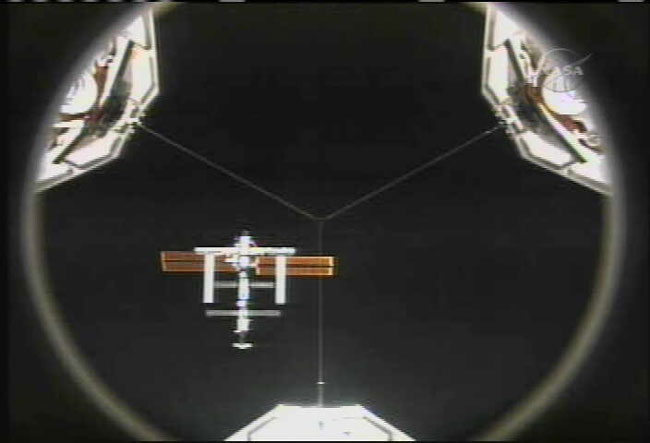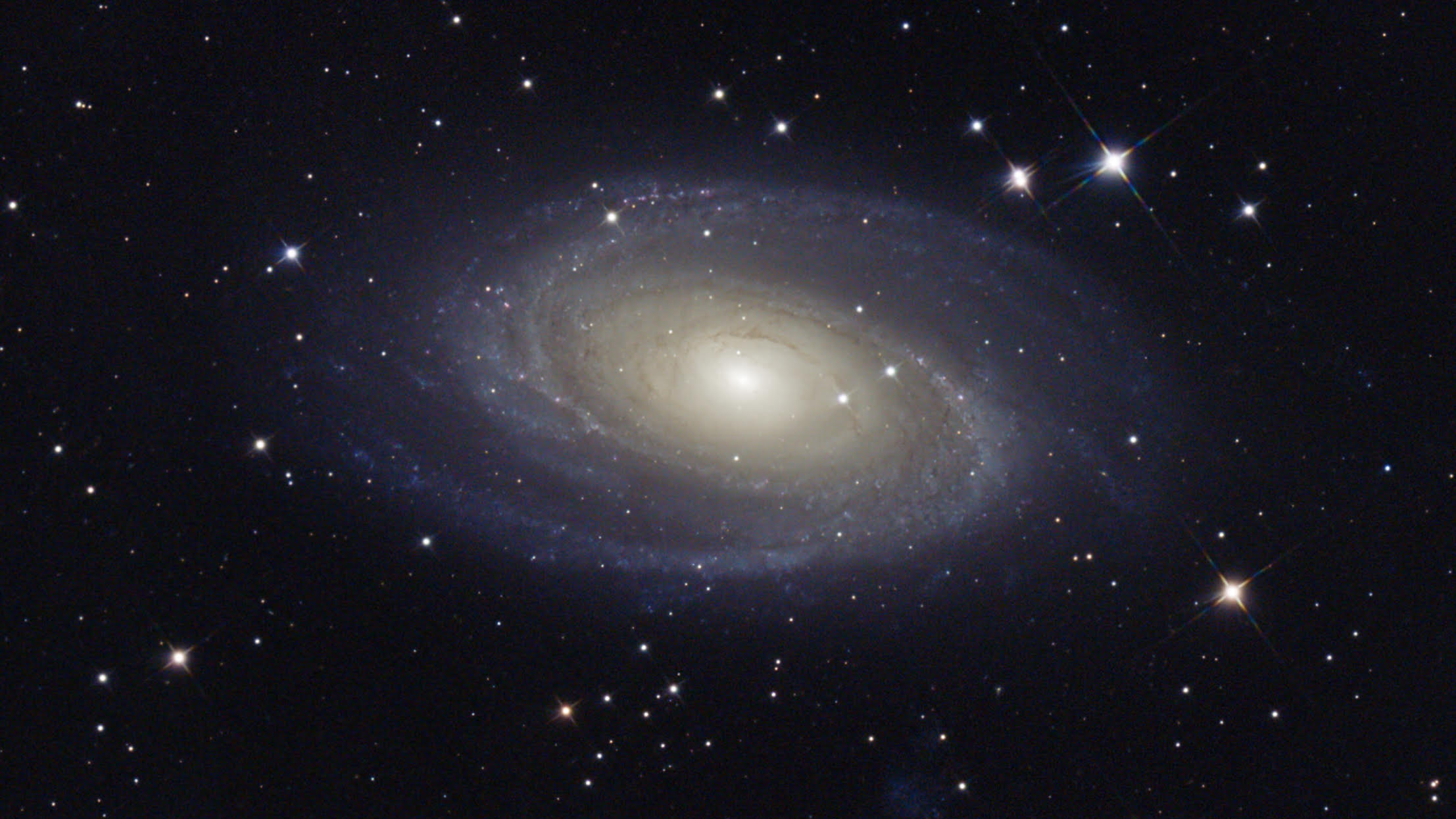Space Shuttle Discovery Arrives at Orbital Station

Thisstory was updated at 12:46 p.m. EDT.
HOUSTON - TheInternational Space Station (ISS) is back at full strength once more afterNASA's Discovery shuttle astronauts delivered a third crewmember to the orbitallaboratory Thursday.
Discovery'sSTS-121 seven-astronaut crew, with shuttle veteran StevenLindsey in command, docked at the ISS right on time at 10:52 a.m. EDT (1452GMT) as the two spacecraft passed over the Southern Pacific Ocean. Ridingaboard the orbiter was German astronaut ThomasReiter, who will return the ISS back to its three-person capacity for thefirst time since the 2003Columbia accident.
"It'sgreat to see you out the window," ISSExpedition 13 flight engineer JeffreyWilliams told the oncoming Discovery astronauts.
Williamshas lived aboard the ISS since April 1 with Expedition 13 commander Pavel Vinogradov. The twoastronauts are in the middle of a six-month mission aboard the space station.
"Goodto see you Jeff, we're proceeding along normally here, you guys look great,"Discovery's STS-121 commander StevenLindsey called to the ISS.
Hatchopening between the two spacecraft occurred 12:30 p.m. EDT (1630 GMT), with a jubilant andwarm welcome of hugs and smiles awaiting the STS-121 shuttle crew.
Get the Space.com Newsletter
Breaking space news, the latest updates on rocket launches, skywatching events and more!
Lindseyflew Discovery through an orbital back flip while stationed about 600 feet (182 meters) below the ISS just before docking. The maneuver allowed theExpedition 13 crew to take a series of high-resolution photographs of theorbiter's tile-covered belly heat shield.
Analystswill sift through the images to seek out any signs of tile damage that couldprevent the orbiter from returning to Earth. So far, shuttle officials havesaid the orbiter's heat shield is in fine shape, but that today's back flipphotographs will allow for a more informed decision.
Inparticular, mission managers hope to learn how a series of about 5,000 gapfillers - which are wedged between some shuttle tiles -performed during Discovery's launch. The gapfillerswere replaced after the orbiter's last flight using a new process to fix themin place.
Anolder gapfiller, installed in 1982, is sticking outfrom under Discovery's port wing just behind its leading edge, but is likelynot a concern, said John Shannon, NASA's deputy shuttle program manager,Wednesday.
Orbital destination
Today'sorbital arrival caps a two-day spaceflight for the STS-121 crew that began witha July4th launch from NASA's Kennedy Space Center in Cape Canaveral,Florida. In addition to Lindsey and Reiter, Discovery launched toward the ISSwith shuttle pilot Mark Kellyand mission specialists Michael Fossum, LisaNowak, StephanieWilson, and PiersSellers.
According toa NASA cargo manifest, Discovery is hauling more than 3.6 tons of supplies,equipment, food and spare parts to the ISS, some of which is tucked inside theorbiter's Italian-built Leonardo module, while more is stowed in thespacecraft's middeck and payload bay platforms.
NASA'sSTS-121 mission is the second orbiter test flight since the Columbia tragedythat destroyed one space shuttle and claimed the lives of seven astronauts. Thespace agency's first post-Columbia flight - STS-114, also aboard Discovery -launched to the ISS in July 2005.
While theSTS-121 mission will perform many of the test objectives left unfinished fromthat first spaceflight, it will more importantly return the ISS back to itsthree-person capacity.
"Fundamentally,we're building the space station as a permanent toehold off of Earth for ourexpansion into space," NASA chief Michael Griffin said before Discovery'slaunch. "Putting three people back aboard is a bigstep forward in the health of the program."
Back tofull strength
Anexperienced long-duration astronaut from his days on the Russian Mir orbitalcomplex, Reiter is Germany's first spaceflyerto the station and the first European Space Agency (ESA) participant in an ISSexpedition. His position on Expedition 13 is part of an arrangement between Russia's Federal Space Agency and ESAofficials.
ButReiter's ISS arrival did not automatically make him part of the station crew.
First, hemust bring in the seat liner for his slot aboard the Russian-built Soyuz spacecraftthat ferried the Expedition 13 crew to the ISS in April. The seat also servesas an escape craft in the event of an emergency. Reiter is scheduled to movehis Soyuz seat liner into position later today.
Busyweek ahead
With thearrival of Discovery at the ISS, a busy week - or about eight days - begins forthe two spacecraft crews.
Latertoday, shuttle astronauts will use Discovery's 50-foot (15-meter) to hand offthe orbiter's sensor-laden inspection boom to the space station's robotic appendage.The boom hand-off will clear Discovery's arm to install the Leonardo cargomodule at the ISS on Friday, beginning the long process of transferringsupplies between the two spacecraft.
The STS-121mission's first spacewalk will begin on July 8, with at least one more plannedfor July 10. A third spacewalk could be added to the mission later depending onDiscovery's available fuel cell propellant.
But despitethat busy schedule, the Expedition 13 astronauts do hope to be good hosts andspend some quality time with their shuttle counterparts.
"I thinkwe'll get an opportunity, like we do when we're on the ground when we'reenjoying times with our friends," Williams said before Discovery launched. "Inthis case, it means floating around the dinner table and sharing ourexperiences. I think those will be the most special times that we have with theshuttle crew here."
- Gallery: Shuttle's First Flight
- Gallery: Rare Space Shuttle Images
- Shuttle Discovery: Complete Mission Coverage
- Great Space Quizzes: Space Shuttle Countdown
- Great Space Quizzes: The Space Shuttle
- Great Space Quizzes: Life in Orbit
Join our Space Forums to keep talking space on the latest missions, night sky and more! And if you have a news tip, correction or comment, let us know at: community@space.com.

Tariq is the Editor-in-Chief of Space.com and joined the team in 2001, first as an intern and staff writer, and later as an editor. He covers human spaceflight, exploration and space science, as well as skywatching and entertainment. He became Space.com's Managing Editor in 2009 and Editor-in-Chief in 2019. Before joining Space.com, Tariq was a staff reporter for The Los Angeles Times covering education and city beats in La Habra, Fullerton and Huntington Beach. In October 2022, Tariq received the Harry Kolcum Award for excellence in space reporting from the National Space Club Florida Committee. He is also an Eagle Scout (yes, he has the Space Exploration merit badge) and went to Space Camp four times as a kid and a fifth time as an adult. He has journalism degrees from the University of Southern California and New York University. You can find Tariq at Space.com and as the co-host to the This Week In Space podcast with space historian Rod Pyle on the TWiT network. To see his latest project, you can follow Tariq on Twitter @tariqjmalik.









